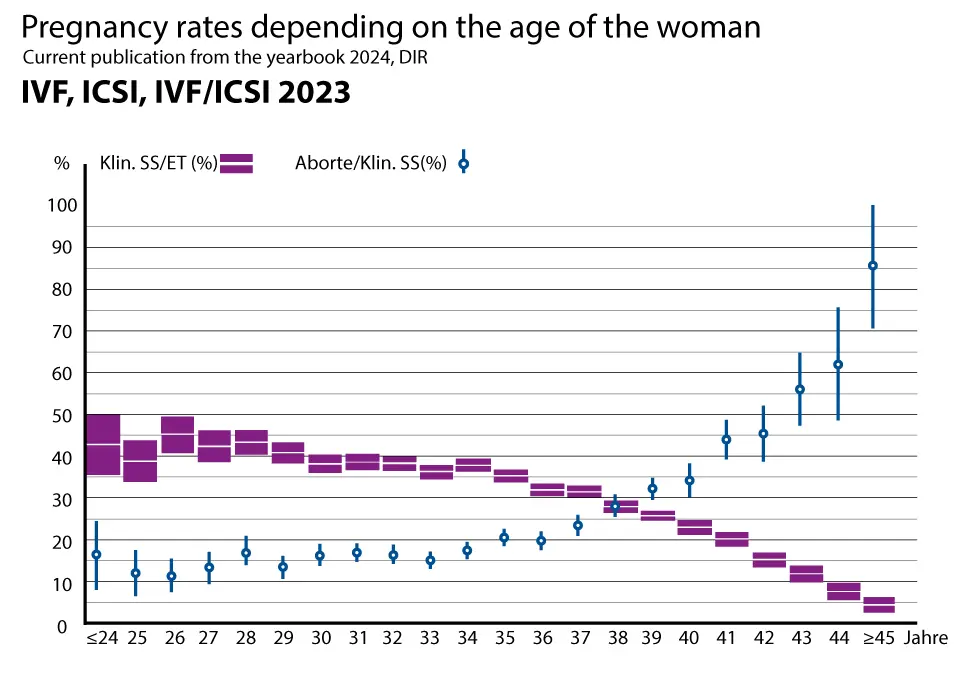Treatment success
In Germany, every 7th – 10th partnership is involuntarily childless. And 1/3 of all couples experience a min. 12-month episode of childlessness. At the same time, the probability of pregnancy per cycle without treatment is 40% in a healthy young couple in their 20s. However, the age of the woman plays a major role in the success rate and thus the probability of pregnancy per cycle decreases to 15-20% at the age of 30-35.
Why doesn’t it work immediately?
In Germany, every 7th to 10th partnership initially remains involuntarily childless. About one-third of all couples experience at least once a phase of over twelve months in which, despite regular ovulation, no pregnancy occurs.
What are the chances of getting pregnant?
For a healthy, young couple around 20 years old, the probability per cycle is about 40%. Many factors are decisive – such as the timing of ovulation, the quality of the eggs, and the early development of the embryo into a blastocyst.
The influence of age
With increasing age of the woman, the probability of pregnancy decreases: Between 30 and 35 years, it is only 15 to 20%. Therefore, it makes sense to have possible causes medically clarified early – and to find targeted ways to increase the chances of a successful pregnancy.
IVF, ICSI and individual success rates
The success rate of getting pregnant is also individual when treated with assisted reproductive technology (ART). Methods such as IVF or ICSI depend strongly in their effectiveness on the woman’s age, possible pre-existing conditions, and the quality of the sperm.
When is ICSI advisable?
The ICSI (Intracytoplasmic Sperm Injection) is primarily used when sperm quality is limited. It is considered a particularly effective method to enable fertilization of the egg – and thus increase the prospect of a pregnancy.
Where can I find success rates?
Current success data for IVF and ICSI can be found in the German IVF Register (D·I·R). There you will receive a transparent overview of the statistical chances according to age group and type of treatment.
The true treatment success: A healthy child
Treatment over multiple cycles
The success rate of an IVF or IVF/ICSI treatment increases with the number of cycles performed. Around 65% of couples have a child after six cycles – an encouraging value that gives hope.
More than just a pregnancy
But not only the occurrence of a pregnancy counts. What is also decisive is how it progresses – until the birth of a healthy child. This is our goal that we pursue together with you: A successful completion of fertility treatment and a happy new beginning for your family.
Very high birth rates are sometimes possible with ideal subpopulations of patients. However, taking the outcome figures of all patient couples over a larger period of time together, a top performing IVF center with very good outcome quality anywhere in the world will at best achieve a birth rate per cycle started that is equivalent to what is possible in nature in couples with good health and fertility, namely around 20%. Most IVF centers fall far short of these possibilities with their outcome numbers.
No IVF center in the world can outperform nature: More than 50% of eggs in women as young as 35 years old have chromosomal maldistributions, i.e. will perish after fertilization, cf. polar body diagnostics. In addition, there are losses due to fertilization of healthy oocytes with chromosomally defective sperm and losses due to chromosomal maldistribution in the further development of early embryos. Few pronuclear stages have the potential to become a blastocyst (embryo 5 days after fertilization), even fewer have the potential to become a child.
On statistical average, out of fifteen pronuclear stages, only three have the potential of developing into a blastocyst. In turn, out of three blastocysts, only one has, on statistical average, the potency to become permanent human life, a child.


